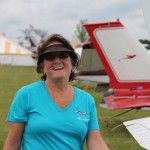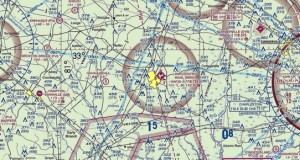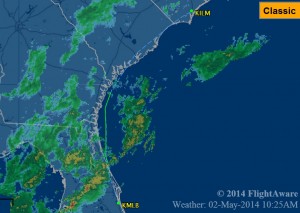
I had to the opportunity to use my PA30 to fly to a GE Technical Users Conference this past week. Beverly came with me this time – mostly to get her away from home and give her a chance to take a break. That worked out quite well.
The flight down: For the flight down, we were watching significant weather move eastward over the entire route of flight (Delaware to Florida). I had planned to leave around 9 am, but an early morning view of the forecast got us moving a few hours earlier. I felt it made more sense to leave at 7 am for a stop at Low Country Airport in Walterboro, SC. Getting this far south would leave a clear path the rest of the way, and made sense for a lunch stop.
 Low Country (KRBW) had relatively inexpensive fuel available, so we topped off and took the time to enjoy a brief lunch. Clean and fresh facility with no surprises – recommended stop. Departing, we were unable to use the GCO from the end of the runway to get a clearance, so I took off westbound to avoid the MOA just to the south. Calling the same approach frequency I used inbound, I was able to pick up my clearance and climbed back to up 8,000′ for the ride south.
Low Country (KRBW) had relatively inexpensive fuel available, so we topped off and took the time to enjoy a brief lunch. Clean and fresh facility with no surprises – recommended stop. Departing, we were unable to use the GCO from the end of the runway to get a clearance, so I took off westbound to avoid the MOA just to the south. Calling the same approach frequency I used inbound, I was able to pick up my clearance and climbed back to up 8,000′ for the ride south.
Landing Melbourne, we discovered that Baer Air was located on the far end of runway 9R. Since that runway is over 10,000′ long, or two miles, I was allowed to land long. There was only one taxiway that wasn’t under construction to this FBO, so if you don’t land long – you tie up the runway. Fuel was reasonable here, but there was a $20 ramp fee per night. People were nice; area clean and safe – cost was worth it. I’ll be back.
The conference: The conference itself was useful for me. I neither use nor maintain the EMS software in my management role, so I did not have the context that others had in the sessions. If nothing else, it gave me the chance to exchange ideas with other managers and the GE reps that were everywhere. Another opportunity to spend time with infrequently seen friends as well. I’m coming home with a few new ideas related to additional support resources, and hope to get the migration going again.
The flight back home: There have been monster storms along the east coast all week. Baltimore got hammered; Pensicola, Fl was hit with 2 feet of rainfall; and a very slow moving front was inching it’s way toward Melbourne and blocking my path home. We arrived at Baer Air just before 7 am; uncovered and loaded the airplane. Bev and I sat in the airplane and fired up the XM Weather. What I saw did not look good at all – lots of intense rain not much chance of getting through it smoothly. I told Bev we should go inside, as I wanted at least an hour to see if morning weather would dissipate for awhile. No sense in staring at the screen.
Bev suggested breakfast, but
we had already turned in our rental car. Baer stepped up though, and gave us a crew car to use for breakfast. We ventured out an an hour so to the Apollo Diner, where we were the youngest people in the place. Breakfast was good though, and we allowed some time for the weather to clear.
Firing up the iPad – significant weather remained across our path. I did see a trend of thinning precipitation close to the cost near Ormond Beach, and decided that a combination of going up high to see what we could of the cells; watching the XM as we approached; listening to preceding traffic; and evaluating controller weather capabilities was worth a try. We launched from toward Ormond Beach and the water route, initially climbing to 7,000′.
Right after takeoff I started communicating my plan to the controller.  I asked for 9,000′, but he told me that wasn’t possible due to another aircraft at the same speed. I balked at that, reminding him I’d be in solid IMC there, and my plan was to go to at least 9,000 to see what I could see. As an alternative – I asked for 11,000′. That was also denied due to crossing traffic, so I remained silent for a few minutes to evaluate my options as I closed on the weather. ATC came back and gave me 9,000′, so I can only presume the other traffic was faster or vectored out of the way. I climbed out of IMC to see the shafts of cells through layers, but not enough to be much help avoiding weather.
I asked for 9,000′, but he told me that wasn’t possible due to another aircraft at the same speed. I balked at that, reminding him I’d be in solid IMC there, and my plan was to go to at least 9,000 to see what I could see. As an alternative – I asked for 11,000′. That was also denied due to crossing traffic, so I remained silent for a few minutes to evaluate my options as I closed on the weather. ATC came back and gave me 9,000′, so I can only presume the other traffic was faster or vectored out of the way. I climbed out of IMC to see the shafts of cells through layers, but not enough to be much help avoiding weather.
There were four of us heading north through this line. The Saratoga in the lead reported moderate rain and moderate turbulence for much of his ride. I told Bev to prepare and tighten up her seat belt as I silently wished I had installed better tie-down straps for the luggage in the rear. The controller was reporting where the cells are and giving vectors to the ‘toga, and also to an SR-22. He was calling out areas of extreme precipitation I never saw on the XM. There was no lightning reported in the area via XM either, nor reported by anyone; just moderate to extreme precip and turbulence.
The ‘toga continued to report moderate turbulence, and now the SR22 did as well. The controller gave continuous reassurance to the ‘toga that he’d be out of it in another 4 miles. I received a vector to 010 degrees to avoid a building cell and entered rain with a few bumps. The SR22 entered his area of moderate turbulence, and now a C-310 came on behind me. That guy (the 310) was asking the controller to find him a way through the line, but the way he said he made me concerned that he should be here at all.
Turbulence started building and the rain increased to moderate. I turned off the autopilot and hand flew forward into what I expected to be an area of difficult weather. The ‘toga was out at this point; and the SR22 directly ahead reporting moderate rain. Bev and I found the moderate turbulence and significant weather, resulting in maximum 30 degree bank excursions for just a few miles. I reported that out, and was given a turn to 340 degrees to avoid an area of extreme precipitation. I made that turn and the rain continued, but the turbulence ended not long after. We were IMC in rain, but we would make it through with no drama.
I was returned to my own navigation with only rain for the rest of the ride – light rain at best. The controller, pilots, and weather resources worked together to get me a smooth and anti-climatic ride home with a tail-wind even. 4.9 Flight hours from Melbourne, Fl to Delaware Airpark, and that includes a stop!
Note: My in-laws tracked us on FlightAware, and I did hear about flying through weather with my best friend Beverly. For the record – there were no thunderstorms in the area, only the potential for those to develop. No lightning in the area either, nor identified cells within 30 nm. The real danger with this flight was a very exciting ride in heavy turbulence that my wife wouldn’t enjoy. No way I wanted that, but would make that same call sitting in my chair this morning.
Excellent blend of both of my careers. Flying and engineering.
Fly safe……
